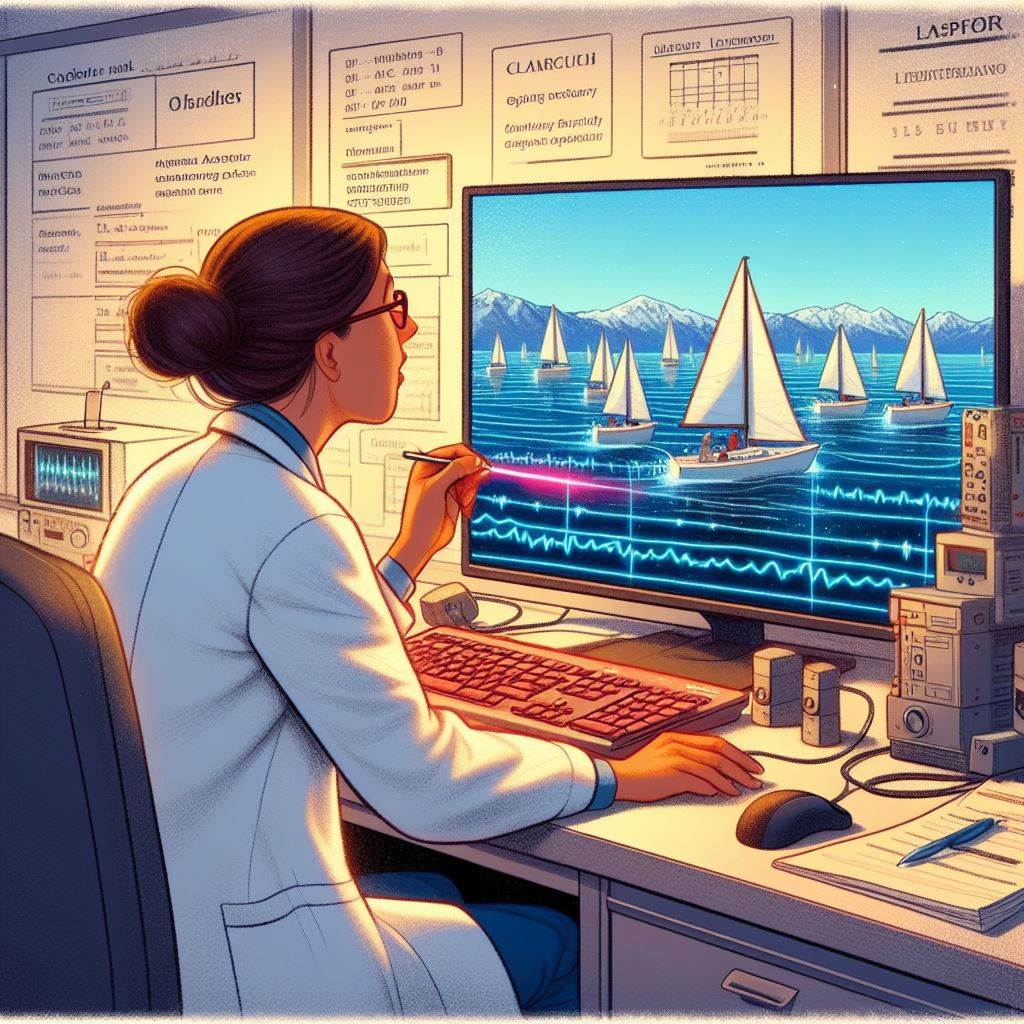Last updated on May 15, 2024
California Institute of Technology, LIGO2 facility, Hanford site, Washington State
“Oh, my giddy aunt, waaay-ting,” Doctor Aurélie Amadi sang at her screen while drumming her fingers on her desk. While she waited for her results, she was watching the sailboats far below on the lake made by a Moaik Kinetic Energy Weapon when it ploughed into the Hanford Campus of Caltech’s Laser Interferometer Gravitational Observatory – LIGO – fifty-five years earlier and wishing she could be there in her tiny dinghy, cares left behind, just her, the wind, and the waves.
As lead researcher of the LIGO2 project, Aurélie was familiar with interminable waits, even from her high-powered computers, as they ground out her results, but this time her impatience showed. The reason for this was LIGO2 had picked up gravitational waves from a neutron star collision with a nearby black hole, twenty light-years away. This celestial billiards game had grave implications for Earth, and Aurélie urgently sought data from observatories worldwide to support her assessment.
When they came, her heart dropped into her shoes.
“Oh crap,” she said, waving to her colleagues. They crowded around her. The results were in terms as plain as a ransom note.
“Projected orbit of object BH814-22-2, shows a 57.2% probability of it intersecting the Sol system in 251.4 standard years.”
Bravo 14 Station: Sector B – 5,500 Astronomical Units from Earth.
Like most military bars, Brewski’s smelled of stale beer, adrenaline, and poor personal hygiene. A metal box with the architectural subtlety of an oubliette, it was regarded by the officers as the lesser evil to locker-room brawls. The ratings needed somewhere to let off steam, and that somewhere was where Hanna McConnell, Earth Fleet Survey Squadron pilot, was holding court to a rapt audience.
“Some men are too driven by targets, and not enough by common sense,” she said as she leaned forward and put her elbows on the table. Her well-muscled arms looked like bridge-supports standing in a sea of empty shot glasses. “They’re like – hey we gotta do dis, den we gotta do dat.”
She looked across the table at Arnold “Dutch” Majer, lead repair tech on the station and winked. Majer was a big man, with a physique rivalling a bulldozer, intense angry eyes, and a volcanic temper. As Hanna expected, a flush of red spread across his face at the slight. Majer’s sensitivity about his accent was well known, and she never missed an opportunity to goad him.
“Dat right?” he growled. He picked up a tumbler and threw the remaining liquor down his throat. “What would a liddle girlie wid her frocks an’ makeup know about dat?”
“Plenty,” Hanna drawled. She and Majer had butted heads over servicing schedules for weeks. “Knowing is growing, but what does a dumb palooka know about girls that he didn’t get from a porn sim?”
Mejer stood quickly, his stool clattering on the bar’s metal floor. He wrenched the table away and, fists clenched, advanced on Hanna, who dived to one side, rolled, and came up in a fighting stance.
“Stand down, pilot,” a voice yelled as the bar door flew open and Captain Dhruv Bretmer, CAG – Survey Squadron, strode in, flanked by two Navy Police Officers. “Stow the Kung-Fu act, you’ve got work to do.”
Hanna relaxed, finger saluted the open-mouthed Mejer, and whispered, “À bientôt.”
Earth Fleet HQ: Naval Station Norfolk, Virginia.
Aurélie walked into the walnut panelled boardroom, tired after her flight from Hanford. The table was surrounded by enough high-powered brass to outfit a marching band, ordinarily enough to set her panicking, yet through sheer willpower she remained calm. To her, this was too important to mess up.
Admiral Kyoko Hoshino, the Commander-in-Chief of Earth Fleet, nodded his greeting.
“Have a seat, Doctor,” he said, extending a hand towards a chair.
Aurélie sat and unpacked her briefing paper. “You’ll have all seen this. It details the anticipated trajectory of a rogue black-hole we call BH814-22-2. The important point is it has a high probability of intersecting the Sol system with catastrophic effect.”
“About a fifty per cent chance, as I read it,” interjected a British officer wearing the name tag ‘Admiral John Hill’.
“Fifty-seven point two,” Aurélie retorted.
“Still, it’s uncertain,” Hill persisted.
“You’re absolutely right, Admiral,” Aurélie responded, searching for the words to deflect his objections. “It isn’t certain. Few things are when calculating the probable trajectories of distant objects.”
“It’s also well into the future,” Hill continued. “Two and a half centuries, at least. Who knows what we will be able to do by then? Maybe we could blast it out of the sky.”
“Admiral, it’s unlikely we could destroy a black hole within the next few millennia, let alone the next two hundred years.” She wasn’t sure if he was playing devil’s advocate, or he was serious. “This is the most powerful force in the known universe. If it entered our solar system, it would gobble up everything in its path: Jupiter, Earth, even the Sun itself. There would be nothing left.”
“If…” Hill left the word hanging.
“Let me put it this way,” she said. “Say I gave you a box with a two-way switch on it and asked you to choose which way to flick the switch. One way guarantees your safety, the other triggers a bomb, but you don’t know which way is which. You have a fifty per cent chance of getting it right. Would you consider that a reasonable gamble?”
“That’s not the same,” he said with a sigh. “We know what is facing us.”
“The odds are similar,” she replied. “In fact, our odds are worse.”
“What would you do, Doctor?” Hoshino asked in a quiet voice.
“I would make certain.”
“How would you do that?”
“We must send someone out there and take precise measurements,” Aurélie said firmly. “And that someone should be me.”
“And if we find this black hole is on a collision course with Sol?”
“Then we have no option but to prepare to evacuate the system,” Aurélie said.
“That’s impossible,” Captain Tony Milsom-Bright of the Earth Fleet research group snapped. “I ran some rough numbers before arriving. The Earth and Sol colonies have a population of about fifteen billion and its growing at a rate of about a quarter of a million a day. The biggest interstellar ship we can build with current technology will berth five-hundred people. That means we would have to build thirty million ships to evacuate the system.”
“You’re talking about FTL ships, I assume?” Hoshino asked.
“Yes Admiral. The power requirement of Hyperspatial Red Line entry is so high, we just don’t have the technology to build anything bigger,” Milsom-Bright said. He shook his head. “We’ve been trying for decades to overcome this, but we’re getting nowhere. We need a new power source.”
“What about slower-than-light ark-ships?”
“Similar problems. We don’t have enough power to push anything that big fast enough. There are no interstellar gas stations. If we could get to a system, we might replenish if they have gas giants, but getting there is the first insurmountable hurdle.” Milsom-Bright said. “Then there’s the time. It took us twenty-five years to build the Oort cloud picket, and that’s just ten thousand battle stations and a quarter of a million bomb-driven laser drones focused on the Red Line entry points to the Sol system. With current engine technology, we can push an STL ship big enough to hold about five hundred thousand people, but not very fast. We’d need to build about thirty or forty thousand of them and plan on an almost endless journey. I won’t even go into the logistics like food, water, and air. Then at the other end, we’d need to slow them down. That means more power.”
“I agree, we need to be certain, even though it takes up more precious time,” Hoshino said. “I propose we send a fast survey ship with Doctor Amadi as the third crew member. There is one problem, though.”
“And that is?” Aurélie asked.
“The location of BH814-22-2 is in Moaik territory. You’d be going behind enemy lines in an unarmed survey ship,” Hoshino said. “And if they catch you, you need not worry about the black hole, because they will kill you, without question.”
“I’m willing to take that chance,” Aurélie said. “This is far too important.”
“Very well,” Hoshino said, “we have a supply ship heading to the Oort on Wednesday. It’s a fifteen-week trip, even with the new reactionless mass engines, so pack plenty of books into your e-Go.”
Bravo 14 Station: CAG Survey Squadron briefing room.
Captain Druv Bretmer stood on a podium in front of Hanna and her survey specialist, Stefery Alekseev, an androgynous figure with a battery of bio-mech instruments clustered around their face.
“Stand easy,” Bretmer commanded. “This is Doctor Aurélie Amadi, an astronomer from LIGO2. She will accompany you on this mission and brief you on the requirements.”
“Nursemaid duty,” Hanna whispered to Stefery and laughed.
“Did you have something to say, McConnell?” Bretmer demanded.
“No sir, I get the drill,” Hanna said. “We handhold the Doc to wherever and get her back safely.”
“I won’t need handholding,” Aurélie countered. “I’ll stay out of your way until we get to the target. Then I’ll do my measurements and we can go home.”
“Where is the target, sir?” Hanna directed her question to Bretmer.
“I can answer that,” Aurélie said. “The target is in sector 15, twenty light years from Earth.”
She tapped a button on the podium and a star chart lit up on the wall-sized monitor behind her, an arrow showing the location of BH814-22-2, over the border in Moaik space.
“This is a rogue black hole. It’s so-called because it came from outside our galaxy and is moving faster than other celestial objects. We must find out where it is going,” Aurélie said. She took a deep breath and went on. “We think it is heading to Sol, but our figures don’t give us absolute certainty. We must go there to find out.”
“An easy one then,” Hanna said with a wide grin. “We bus Doc here into enemy territory and then, if we don’t get our butts shot off by the Featherheads, she does some geometry, and we bring home the bacon. Got it.”
“You’ll also be equipped with an entangled particle transmitter, which can communicate instantly with its partner on Earth,” Bretmer said. “As soon as you get Doctor Amadi’s results, you must transmit them home.”
“This is the failsafe, right?” Hanna said. “In case we get our butts shot off.”
“In a word, yes,” Aurélie replied. “The consequences of not getting our findings back home to Earth are incalculable.”
“How incalculable?”
“The end of everything. Billions could die.”
“One other thing, sir,” Hanna asked, “how come we got volunteered?”
“Your ship is the only one with the space for a bulky transmitter, the power to follow an object moving at ten per cent of lightspeed, and a pilot with knowledge of the region. It can only be you,” Bretmer said.
Hanna grinned. “No pressure then, boss.”
… To be continued …


Be First to Comment